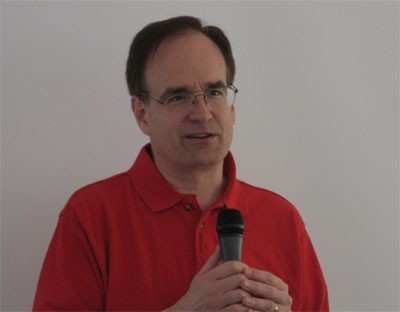Lindbergh's "New Spirit Of St. Louis" Comes Home
The New Spirit of St. Louis -- the Lancair Columbia 300 that
carried Erik Lindbergh from New York to Paris in 2002, recreating
his grandfather’s historic flights -- is headed home to the
city for which it’s named.

At a Tuesday press conference at Lakeland 2007, Columbia
Aircraft Manufacturing Corporation president Wan Abd Majid handed
over the keys to the New Spirit to the St. Louis Science Center, an
institution that was central in the New Spirit’s most famous
flights.
Gregg Maryniak, director of the J.S. McDonnell Planetarium, Vice
President Aerospace Sciences at the St. Louis Science Center, said
that the institution and the New Spirit already have a lot of
history.

“The St. Louis Science Center was deeply involved in the
Lindbergh flights in 2002 as well as subsequent X Prize
activities,” said Maryniak. “We’re tremendously
excited to receive the New Spirit and thank Columbia for its
generosity on so many levels. It’s great to see this historic
aircraft return to St. Louis. It may be retired from flight, but it
will continue to support aerospace education in our region for
years to come.”
Maryniak (shown below) explained that the New Spirit will become
part of the St. Louis Science Center’s flight education
program for young people, including economically disadvantaged St.
Louis teens. The program is primarily offered in a facility that
was used as mission control for Lindbergh’s trans-Atlantic
flight and was later employed for the same purpose during
SpaceShipOne’s successful bid to win the $10 million Ansari X
Prize award in 2004.
Maryniak’s personal connection to the New Spirit goes back
even farther than that of the St. Louis Science Center. Maryniak
was Executive Director of the X Prize Foundation when Erik
Lindbergh marked the 75th anniversary of Charles Lindbergh’s
historic flights by recreating them in the New Spirit. He credits
the funds raised by Lindbergh’s flights and the media
attention that they generated with breathing life into the X Prize
Foundation at a time when it needed a lift.

“The Foundation was facing a lot of challenges at that
time and Erik’s activities, which were enabled by Columbia
and the New Spirit, gave the X Prize the boost it needed to keep
moving forward toward its ultimate goal of motivating the first
privately funded space flights. The X Prize might not have
succeeded if it weren’t for Erik Lindbergh, the genrosity of
Columbia and the New Spirit.”
In addition to benefiting the X Prize, Lindbergh’s flights
also raised money for the Arthritis Foundation and the Lindbergh
Foundation.
 The New Spirit was originally
conceived as Columbia 300 SN 40003, just the third Columbia ever
built and the conforming prototype that performed the certification
flight tests for the model. When Lindbergh approached Columbia
about using one of their aircraft for his planned flights, the
management team set about exploring just what would need to be done
to make it possible.
The New Spirit was originally
conceived as Columbia 300 SN 40003, just the third Columbia ever
built and the conforming prototype that performed the certification
flight tests for the model. When Lindbergh approached Columbia
about using one of their aircraft for his planned flights, the
management team set about exploring just what would need to be done
to make it possible.
“We looked at the requirements for Lindbergh’s
flights, particularly the non-stop, trans-Atlantic leg due to its
length and exposure to danger,” said Columbia Aircraft
Manufacturing Corporation Vice President Ron Wright. “As it
turned out, very little needed to be modified on the aircraft other
than increasing fuel capacity to provide the necessary
range.”
The aircraft’s wing was ultimately replaced with a
modified, “super wet” wing with a 240 gallon capacity.
The back seat was also removed to make room for an 85 gallon
auxiliary fuel tank. Satellite video, telephone and telemetry gear
was added to the cockpit to assist with communications and
documenting the flight for a History Channel special. Other than
that, the aircraft was essentially stock.
“The Columbia airframe is extremely robust,” Wright
said. “The New Spirit took off about 1,000 pounds over max
gross weight without any problem and then carried Erik from New
York to Paris at an average speed of better than 210 miles per
hour. It made the trip about twice as fast as the original Spirit.
Upon landing in Paris, Erik reported that he still had better than
four and a half hours of fuel remaining. He could have kept right
on going to Russia if he’d wanted to.”
Lindbergh said the New Spirit of St. Louis helped to change his
life. “I had been a flight instructor several years earlier,
but severe rheumatoid arthritis had made piloting an aircraft
almost impossible. A new drug called Enbrel helped me regain my
mobility and gave me the chance to undertake this project.

"Then the people at Columbia and the New Spirit provided me with
the support and the platform to make my dream a success," Lindbergh
said. "I owe them a debt of gratitude for helping me relaunch my
aviation career.”
 Airbus Racer Helicopter Demonstrator First Flight Part of Clean Sky 2 Initiative
Airbus Racer Helicopter Demonstrator First Flight Part of Clean Sky 2 Initiative Diamond's Electric DA40 Finds Fans at Dübendorf
Diamond's Electric DA40 Finds Fans at Dübendorf ANN's Daily Aero-Term (04.23.24): Line Up And Wait (LUAW)
ANN's Daily Aero-Term (04.23.24): Line Up And Wait (LUAW) NTSB Final Report: Extra Flugzeugbau GMBH EA300/L
NTSB Final Report: Extra Flugzeugbau GMBH EA300/L Classic Aero-TV: 'Never Give Up' - Advice From Two of FedEx's Female Captains
Classic Aero-TV: 'Never Give Up' - Advice From Two of FedEx's Female Captains







